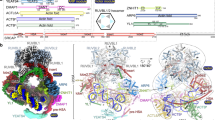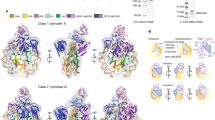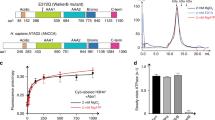Abstract
Histone variant H2A.Z, a universal mark of dynamic nucleosomes flanking gene promoters and enhancers, is incorporated into chromatin by SRCAP (SWR1), an ATP-dependent, multicomponent chromatin-remodeling complex. The YL1 (Swc2) subunit of SRCAP (SWR1) plays an essential role in H2A.Z recognition, but how it achieves this has been unclear. Here, we report the crystal structure of the H2A.Z-binding domain of Drosophila melanogaster YL1 (dYL1-Z) in complex with an H2A.Z–H2B dimer at 1.9-Å resolution. The dYL1-Z domain adopts a new whip-like structure that wraps over H2A.Z–H2B, and preferential recognition is largely conferred by three residues in loop 2, the hyperacidic patch and the extended αC helix of H2A.Z. Importantly, this domain is essential for deposition of budding yeast H2A.Z in vivo and SRCAP (SWR1)-catalyzed histone H2A.Z replacement in vitro. Our studies distinguish YL1-Z from known H2A.Z chaperones and suggest a hierarchical mechanism based on increasing binding affinity facilitating H2A.Z transfer from SRCAP (SWR1) to the nucleosome.
This is a preview of subscription content, access via your institution
Access options
Subscribe to this journal
Receive 12 print issues and online access
$189.00 per year
only $15.75 per issue
Buy this article
- Purchase on Springer Link
- Instant access to full article PDF
Prices may be subject to local taxes which are calculated during checkout







Similar content being viewed by others
References
Henikoff, S. & Smith, M.M. Histone variants and epigenetics. Cold Spring Harb. Perspect. Biol. 7, a019364 (2015).
Venkatesh, S. & Workman, J.L. Histone exchange, chromatin structure and the regulation of transcription. Nat. Rev. Mol. Cell Biol. 16, 178–189 (2015).
Kobor, M.S. et al. A protein complex containing the conserved Swi2/Snf2-related ATPase Swr1p deposits histone variant H2A.Z into euchromatin. PLoS Biol. 2, E131 (2004).
Mizuguchi, G. et al. ATP-driven exchange of histone H2AZ variant catalyzed by SWR1 chromatin remodeling complex. Science 303, 343–348 (2004).
Krogan, N.J. et al. A Snf2 family ATPase complex required for recruitment of the histone H2A variant Htz1. Mol. Cell 12, 1565–1576 (2003).
Luk, E. et al. Stepwise histone replacement by SWR1 requires dual activation with histone H2A.Z and canonical nucleosome. Cell 143, 725–736 (2010).
Wu, W.H. et al. Swc2 is a widely conserved H2AZ-binding module essential for ATP-dependent histone exchange. Nat. Struct. Mol. Biol. 12, 1064–1071 (2005).
Wu, W.H. et al. N terminus of Swr1 binds to histone H2AZ and provides a platform for subunit assembly in the chromatin remodeling complex. J. Biol. Chem. 284, 6200–6207 (2009).
Ranjan, A. et al. Nucleosome-free region dominates histone acetylation in targeting SWR1 to promoters for H2A.Z replacement. Cell 154, 1232–1245 (2013).
Luk, E. et al. Chz1, a nuclear chaperone for histone H2AZ. Mol. Cell 25, 357–368 (2007).
Obri, A. et al. ANP32E is a histone chaperone that removes H2A.Z from chromatin. Nature 505, 648–653 (2014).
Mao, Z. et al. Anp32e, a higher eukaryotic histone chaperone directs preferential recognition for H2A.Z. Cell Res. 24, 389–399 (2014).
Gursoy-Yuzugullu, O., Ayrapetov, M.K. & Price, B.D. Histone chaperone Anp32e removes H2A.Z from DNA double-strand breaks and promotes nucleosome reorganization and DNA repair. Proc. Natl. Acad. Sci. USA 112, 7507–7512 (2015).
Hong, J. et al. The catalytic subunit of the SWR1 remodeler is a histone chaperone for the H2A.Z-H2B dimer. Mol. Cell 53, 498–505 (2014).
Zhou, Z. et al. NMR structure of chaperone Chz1 complexed with histones H2A.Z-H2B. Nat. Struct. Mol. Biol. 15, 868–869 (2008).
Suto, R.K., Clarkson, M.J., Tremethick, D.J. & Luger, K. Crystal structure of a nucleosome core particle containing the variant histone H2A.Z. Nat. Struct. Biol. 7, 1121–1124 (2000).
Liu, C.P. et al. Structure of the variant histone H3.3–H4 heterodimer in complex with its chaperone DAXX. Nat. Struct. Mol. Biol. 19, 1287–1292 (2012).
Barbera, A.J. et al. The nucleosomal surface as a docking station for Kaposi's sarcoma herpesvirus LANA. Science 311, 856–861 (2006).
Makde, R.D., England, J.R., Yennawar, H.P. & Tan, S. Structure of RCC1 chromatin factor bound to the nucleosome core particle. Nature 467, 562–566 (2010).
Yang, D. et al. Nα-acetylated Sir3 stabilizes the conformation of a nucleosome-binding loop in the BAH domain. Nat. Struct. Mol. Biol. 20, 1116–1118 (2013).
Kato, H. et al. Architecture of the high mobility group nucleosomal protein 2-nucleosome complex as revealed by methyl-based NMR. Proc. Natl. Acad. Sci. USA 108, 12283–12288 (2011).
Kato, H. et al. A conserved mechanism for centromeric nucleosome recognition by centromere protein CENP-C. Science 340, 1110–1113 (2013).
McGinty, R.K., Henrici, R.C. & Tan, S. Crystal structure of the PRC1 ubiquitylation module bound to the nucleosome. Nature 514, 591–596 (2014).
Armache, K.J., Garlick, J.D., Canzio, D., Narlikar, G.J. & Kingston, R.E. Structural basis of silencing: Sir3 BAH domain in complex with a nucleosome at 3.0 Å resolution. Science 334, 977–982 (2011).
Hondele, M. et al. Structural basis of histone H2A–H2B recognition by the essential chaperone FACT. Nature 499, 111–114 (2013).
Kemble, D.J., McCullough, L.L., Whitby, F.G., Formosa, T. & Hill, C.P. FACT disrupts nucleosome structure by binding H2A-H2B with conserved peptide motifs. Mol. Cell 60, 294–306 (2015).
Krissinel, E. & Henrick, K. Inference of macromolecular assemblies from crystalline state. J. Mol. Biol. 372, 774–797 (2007).
Otwinowski, Z. & Minor, W. Processing of X-ray diffraction data collected in oscillation mode. Methods Enzymol. 276, 307–326 (1997).
Collaborative Computational Project, No. 4. The CCP4 suite: programs for protein crystallography. Acta Crystallogr. D Biol. Crystallogr. 50, 760–763 (1994).
McCoy, A.J. et al. Phaser crystallographic software. J. Appl. Crystallogr. 40, 658–674 (2007).
Emsley, P. & Cowtan, K. Coot: model-building tools for molecular graphics. Acta Crystallogr. D Biol. Crystallogr. 60, 2126–2132 (2004).
Adams, P.D. et al. PHENIX: building new software for automated crystallographic structure determination. Acta Crystallogr. D Biol. Crystallogr. 58, 1948–1954 (2002).
Laskowski, R.A., Macarthur, M.W., Moss, D.S. & Thornton, J.M. Procheck: a program to check the stereochemical quality of protein structures. J. Appl. Crystallogr. 26, 283–291 (1993).
Yang, J.G. & Narlikar, G.J. FRET-based methods to study ATP-dependent changes in chromatin structure. Methods 41, 291–295 (2007).
Miranda, W.E., Noskov, S.Y. & Valiente, P.A. Improving the LIE Method for binding free energy calculations of protein-ligand complexes. J. Chem. Inf. Model 55, 1867–1877 (2015).
Acknowledgements
We thank Y. Bai, B. Zhu, C. Tang and Y. Huang for invaluable suggestions; Shanghai Synchrotron Radiation Facility beamline scientists for technical support with data collection; Y. Chen, H. Wang and J. Wang for advice on ITC analysis; and X. Yu for assistance with AUC analysis. The study was supported by grants from the Chinese Ministry of Science and Technology (2015CB856200 and 2013CB910203 to Z. Zhou) and grants from the Natural Science Foundation of China (31521002, 31270833 and 31123003 to Z. Zhou). C.W. and A.R. are supported by the Janelia Research Campus, Howard Hughes Medical Institute. F.W. and D.W. are supported by the Center for Cancer Research, US National Cancer Institute. Z. Zhou is supported as a CAS-Novo Nordisk Great Wall Professor.
Author information
Authors and Affiliations
Contributions
X. Liang performed the ITC experiments and histone deposition assays. S.S. reconstituted the complex and determined the structure. L.P. and J.Z. performed the ChIP-qPCR experiments and subcellular colocalization assays. A.R., F.W., D.W. and L.P. performed the EMSAs and histone exchange assays. X. Liu and H.F. performed NMR experiments. Q.Z. and J.L. performed binding-energy calculations. Y.H., Z. Zhang, L.H. and G.L. performed biochemical experiments and data analysis. C.W. and Z. Zhou designed the study, analyzed the data and wrote the manuscript. All authors contributed to experimental design and commented on the manuscript.
Corresponding authors
Ethics declarations
Competing interests
The authors declare no competing financial interests.
Integrated supplementary information
Supplementary Figure 1 Single-chain histone dimers form stable 1:1 complexes with YL1-Z (Swc2-Z).
(a), The single chain H2A.Z–H2B and single chain H2A–H2B used in this study. Shown on top are the sequence alignments of human and yeast single chain H2A.Z–H2B (scZB) and corresponding secondary structures. H2B (red), H2A.Z (yellow), and extended H2A.Z αC-helix (orange). Yeast-specific residues colored in red. (b), Sedimentation velocity experiments show that human YL1-Z (hYL1-Z) and Drosophila YL1-Z (dYL1-Z) mainly form a 1:1 complex with human scZB (hscZB), in both 0.2 M NaCl and 0.5 M NaCl. The svedbergs value (S) and molecular weight (kD) are shown in each figure. (c), Sedimentation equilibrium experiments show that both human YL1-Z residues 1–77 and human YL1-Z residues 12–77 form a 1:1 complex with yeast scZB in 0.1 M NaCl. Removal of 11 residues within hYL1-Z Rn-region shows no effect on stoichiometry of the complex.
Supplementary Figure 2 Human YL1-Z is intrinsically disordered.
(a), 1H–15N heteronuclear single quantum coherence (HSQC) spectra of human YL1-Z in histone-free form. The backbone 1H–15N resonances of hYL1 residue 1–77 were fully assigned and the peaks representing YL1-Z residues were labeled. (b), The hYL1-Z backbone Cα chemical shift deviations corresponding to random coil values are presented. The results show that hYL1-Z largely remains as a disordered polypeptide.
Supplementary Figure 3 Typical ITC data with fitting curves.
(a), Isotherms for titration of hYL1-Z (WT and mutants) to scZB and scAB in 0.2 M NaCl. (b), Isotherms for titration of hYL1-Z (WT and mutants) to scZB or scAB (WT and mutants) in 0.5 M NaCl.
Supplementary Figure 4 Crystal packing of the dYL1-Z–H2A.Z–H2B crystal and the omit map for dYL1-Z.
(a), Cross-section of the crystal lattice for dYL1-Z–H2A.Z–H2B complex. Two complex molecules in the neighbouring asymmetric units are shown in surface diagram or ribbon diagram. Colored in orange are H2A.Z αC-helix and L2-loop showing conformation changes. The crystal packing reveals binary interactions between two H2A.Z–H2B dimers and both dYL1-Z Rn- and Rc- regions. (b), Close view of dYL1-Z Rn-region bound to scZB. The dYL1-Z Rn interacts with H2A.Z residues (E64, E67, K74, D93, E94, E95), which are either identical (E64, E67, D93, E94, E95) or highly conserved (K74) in H2A. (c), The omit map of dYL1-Z generated by PHENIX. The map is contoured at the 1.0- level at 1.9-Å resolution. The figure was generated by Pymol. dYL-1 (magenta), H2A.Z (yellow), H2B (red), and the extended H2A.Z αC-helix (orange).
Supplementary Figure 5 Effect of yeast Swc2-Z regional mutations on H2A.Z exchange activity and H2A.Z occupancy.
(a), Schematic view of Swc2-Z(YL1-Z) family and Mut2 regions subject to mutagenesis. Residues substituted with alanine are labeled "A". (b), Phenotypes of WT, swc2Δ, swc2-ΔZ (Swc2 residues 1–89 are deleted) strains. (c), ChIP-PCR for H2A.Z-HA occupancy in yeast strains containing Swc2 WT, Swc2-Mut2 and Swc2-ΔZ, in which Swc2 residues 1–89 are deleted. (d), Histone exchange assay for SWR1 WT, SWR1 (Swc2 Mut2) and SWR1 (Swc2-ΔZ). The reaction mix contained 5 nM nucleosome, 2 nM SWR1, 5 nM H2A.Z 3×Flag–H2B dimer and 1 mM ATP.
Supplementary Figure 6 Comparative analysis of H2A.Z–H2B recognition modes for H2A.Z or H2A chaperones.
Structures in comparison are H2A.Z chaperone YL1-Z, Anp32e-ZID (4CAY) (Obri, A. et al. Nature 505, 648-53, 2014), Swr1-Z (4M6B) (Hong, J. et al. Mol Cell 53, 498-505, 2014), Chz1-Z (2JSS) (Zhou, Z. et al. Nat Struct Mol Biol 15, 868-9, 2008) and H2A chaperone FACT subunit Spt16 residue 915–943(4KHO) (Hondele, M. et al. Nature 499, 111-4, 2013) and residue 958–999 (4WNN) (Kemble, D.J. et al. Mol Cell 60, 294-306, 2015). The chaperone structures are shown in ribbon mode and histone structures in surface mode. (a), Interaction between H2A.Z-H2B dimer and H2A.Z chaperone YL1-Z (left), Anp32e-ZID (middle) and Swr1-Z (right). Structures of YL1-Z, Anp32e-ZID and Swr1-Z are colored in magenta, cyan and blue. The H2A.Z αC-cleft and H2B pocket recognized by H2A.Z chaperones are highlighted in a dotted rectangle and circle, respectively. (b), Close view of H2A.Z αC-cleft (right) and H2B pocket (left) in contact with H2A.Z chaperones. Structures of YL1-Z, Anp32e-ZID, Swr1-Z are superimposed. While YL1-Z interacts with the H2A.Z αC-cleft using the end of the α1-helix followed by a β-bend, Anp32e-ZID and Swr1-Z both use a short helix for interaction. Importantly, YL1-Z, Anp32e-ZID and Swr1-Z each bury a similar aromatic residue (Y44, F623, Y235, respectively) in the H2B pocket. (c), Structure of yeast FACT subunit Spt16 residues 915–956 (colored in green) interacting with H2A–H2B (left) and close view of the contact with H2B pocket (right). The side chain of F939 is colored in orange for clear view. (d), Structure of yeast FACT subunit Spt16 residues 958–999 (colored in orange) interacting with H2A–H2B (left) and close view of the contact with H2B pocket (right). (e), Structure comparison of YL1-Z and Chz1. Chz1 residues 63–124 (green) are shown in ribbon representation. Binding of YL1-Z and Chz1 at the H2A.Z α1–α2 patch, highlighted in the dotted circle, are mutually exclusive.
Supplementary Figure 7 Binding energy of H2A.Z–H2B in complex with YL1-Z, Swr1-Z, Anp32e ZID, Chz1-Z or the H2A.Z nucleosome.
The structures used for calculation are YL1-Z (this study), Anp32e-ZID (4CAY) (Obri, A. et al. Nature 505, 648-53, 2014), Swr1-Z (4M6B) (Hong, J. et al. Mol Cell 53, 498-505, 2014), Chz1-Z (2JSS) (Zhou, Z. et al. Nat Struct Mol Biol 15, 868-9, 2008), H2A.Z nucleosome (H2A.Z Nucleosome, 1F66) (Suto, R.K. et al. Nat Struct Biol 7, 1121-4, 2000). Highlighted in red are values calculated by using YL1-Z, include YL1 residue 24–46 (YL1-Z Rc-1 and Rc-2) interacting with H2A.Z αC-cleft and H2B pocket, and YL1 residue 46–69 (YL1-Z Rc-3) interacting with H2A.Z α1–α2 patch.
Supplementary information
Supplementary Text and Figures
Supplementary Figures 1–7 and Supplementary Tables 1–2 (PDF 1754 kb)
Supplementary Data Set 1
Uncropped gels shown in main figures (PDF 6127 kb)
Rights and permissions
About this article
Cite this article
Liang, X., Shan, S., Pan, L. et al. Structural basis of H2A.Z recognition by SRCAP chromatin-remodeling subunit YL1. Nat Struct Mol Biol 23, 317–323 (2016). https://doi.org/10.1038/nsmb.3190
Received:
Accepted:
Published:
Issue Date:
DOI: https://doi.org/10.1038/nsmb.3190
This article is cited by
-
Mammalian PERIOD2 regulates H2A.Z incorporation in chromatin to orchestrate circadian negative feedback
Nature Structural & Molecular Biology (2022)
-
Gene Co-expression Analysis of the Human Substantia Nigra Identifies ZNHIT1 as an SNCA Co-expressed Gene that Protects Against α-Synuclein-Induced Impairments in Neurite Growth and Mitochondrial Dysfunction in SH-SY5Y Cells
Molecular Neurobiology (2022)
-
Tip60 activates Hoxa9 and Meis1 expression through acetylation of H2A.Z, promoting MLL-AF10 and MLL-ENL acute myeloid leukemia
Leukemia (2021)
-
The roles of histone variants in fine-tuning chromatin organization and function
Nature Reviews Molecular Cell Biology (2020)
-
Znhit1 controls intestinal stem cell maintenance by regulating H2A.Z incorporation
Nature Communications (2019)



